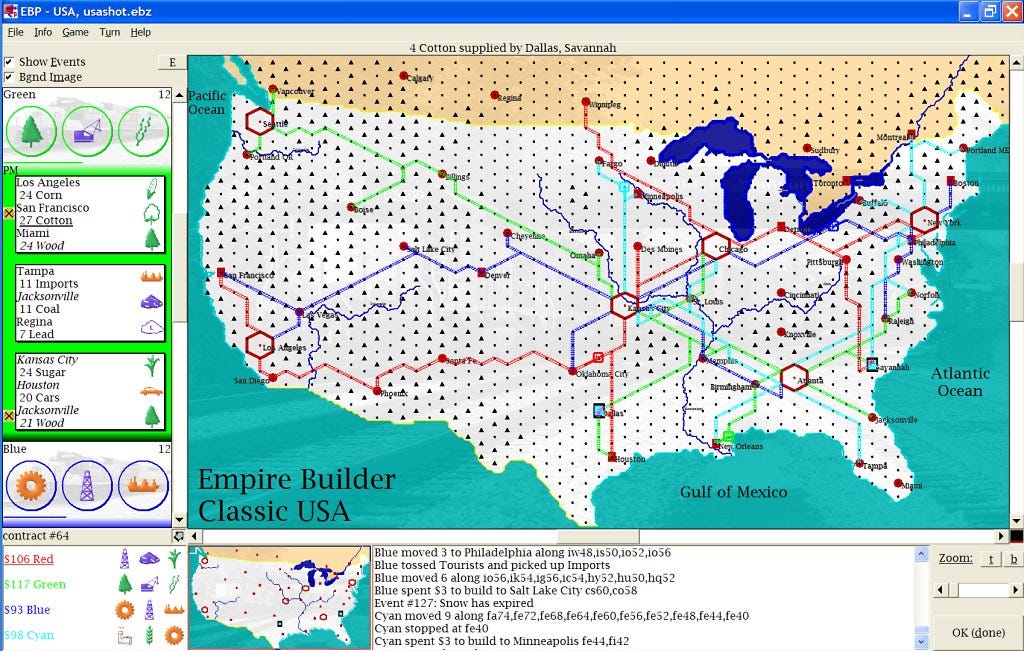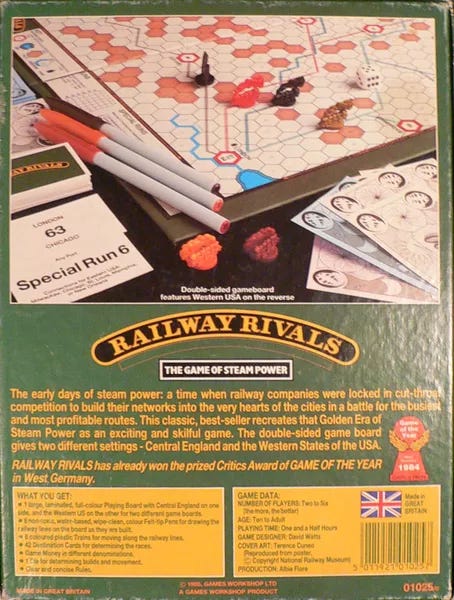Empire Builder / Railway Rivals
So far we’ve had games about dungeon crawling, civilization building, running a business, words, negotiations, cards and starting a colony. Games (often, but not always) have a theme. Games are also built with a variety of components: dice, cards, boards, spinners, miniatures and — in the case of role playing games — little more than the player’s imaginations.
Often these match up in expected ways expect. I suppose you could make a game where you are a ruthless CEO trying to squeeze every last dollar of profit by building the Cootie … but I haven’t seen it. And when I think of running a train company, my first thought runs towards shares, dividends and routes. That’s natural, as I play 18xx.
But for many others, when I say “Trains,” they naturally think …. Crayons.
Darwin Bromley and Bill Fawcett’s Empire Builder lets each player build up their rail network by connecting major and minor cities on a dotted hex grid. Players use crayons to mark their track. Players only start with a small amount of money: to get more you’ll pick up some goods at a city and deliver them at a city that wants them, which takes time — exactly how long depending on how direct the track you’ve built is (and how good a locomotive you’ve got).
So you build more track. To connect in more cities. To get a wider variety of goods. Keep going until one player has turned their initial $40 million into $250 million AND a network of rails that spans the continent. The rules — and components — are simplicity itself. The challenge comes from needing to start small and keep a steady stream of income while also positioning yourself for longer, more profitable, runs. You wouldn’t want your Seattle to Los Angeles run to take you through Florida, obviously, but a straight North-South run wouldn’t be helpful either. How do you balance it?
And you’ll probably not want to spend too much money tunneling through mountains. A screenshot is worth a thousand words.

While researching this article1 I assumed that the “pick up and deliver” mechanism started earlier — much earlier — and that Empire Builder merely popularized it. The fact that Google’s AI was so confident stating Empire Builder started it all … reinforced my belief.
Eventually I remembered Railway Rivals.
David G. Watt’s Railway Rivals has a simpler map and no pick up and deliver. Players get some investment each turn to build track and link up cities. When enough cities are linked, players race between two random cities to earn money. If you squint this could be a pick up and deliver, but apart from “races instead of goods” the games are broadly similar.
So Empire Builder cannot claim to be the first.
Both games spawned a genre: not just of Pickup-and-deliver games in general, but “Crayon Rails” games in particular. Empire Builder begat Eurorails, British Rails, North American Rails, as well as maps in India, China, Japan and ScienceFiction (Martian Rails) and Fantasy (Iron Dragon) settings. The German edition of Railway Rivals won the coveted Spiel des Jahres award, and has numerous maps and reprints in it’s own right. Certainly in the US the Empire Builder Series is more popular, but then again, that is the series created by the US company, not the UK one.
Both titles are simple enough to be understood and played by small children, but interesting enough that even hardcore games repeatedly play them. The Empire Builder series is still a staple at “Puffing Billy” train-games tournaments.
From the vantage point where I sit, Empire Builder is an easy entry in the 100 Most Influential Games of the 20th Century, which doesn’t mean that Railway Rivals isn’t. There’s something about trains that gamers love, and I see no reason why both should not be considered. Eventually we’ll have to whittle it down to one hundred, but right now let us appreciate both designs.
The author would ask your indulgence in assuming that any publication delays are caused by extensive research…





